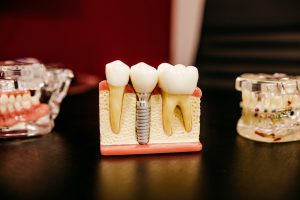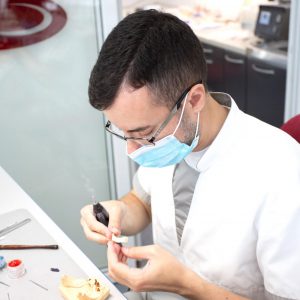The use of zirconia in medicine started in the 1970s as a hip replacement material. It was only introduced into dentistry 20 years later in the 1990s for root canal posts. Zirconia has also been adopted into dental practices as an alternative to metal-infused restorations. Due to their biocompatibility and excellent mechanical properties zirconia has been successfully used in recent years as a dental biomaterial.
Zirconia does not appear naturally, it is artificially produced. Nevertheless, it is made of a mineral called Zircon that is present on the surface of the earth’s crust. It is a mineral that can be found in nature and is the source of Zirconium which is a silver metal. It is incredibly solid and can form various other compounds among which – Zirconium Dioxide (aka Zirconia).
Contents
Types of dental bridges
 Porcelain fused to metal
Porcelain fused to metal
The most common material used for dental crowns in the 1960s was porcelain fused to metal (PFM) and remained a standard in dental restorations for decades. It is still used nowadays and there is a good reason for that – these materials form a strong restoration which has proven its durability over time.
The disadvantage of this PFM is that it compromises the natural and translucent look of natural teeth despite providing the vigour needed for a long-lasting restoration. It does not meet the aesthetical standard of natural teeth as they appear grey and matte. Nowadays, patients opt for such crowns for the back teeth where they remain unseen.
Glass-Ceramic
Dental glass–ceramics were highly attractive back in the 1980s as they offered an outstanding combination of aesthetics and biocompatibility. The first enterprise to manufacture glass-ceramic restorations was Corning Inc. in 1984.
The crowns appeared far superior to their forerunner as far as natural and realistic appearance is concerned. However there was one significant downside – they lacked the strength of metal. Glass-ceramic crowns were very delicate – they would chip and break off easily. That would render them inefficient in the long run although they successfully met the aesthetic needs of patients.
 Zirconia
Zirconia
It was not until the 2000s that zirconia became a popular material used for restorations. With technological advancement, dental professionals were able to use new approaches to work with this new, powdered substance.
Zirconia for teeth offers a potent mix of metal-like endurance and a natural-looking appearance. It’s also fully biocompatible and provides a suitable alternative for those who are allergic to metals. Zirconia has both the durability of metal with the translucent surface of a real tooth.
The successful production of a zirconia restoration requires techniques that differ from those that apply to porcelain fused to metal (PFM). The goal is to minimize chipping and fractures caused by improper design and processing.
Still, the dental laboratory has challenges related to the production of zirconia crowns and restorations. The most notable one is the difficulty in margin marking – not to make them ambiguous or too sharp.
Another challenge is chipping during milling of the zirconia, caused by design.
Zirconia crown benefits
 Biocompatibility & Aesthetics
Biocompatibility & Aesthetics
Zirconia is the number one option for many dental professionals due to its biocompatibility. Furthermore, fewer bacteria attach to the zirconia surface. When metal mixes with bacteria in the dental plaque, marks appear on the gum surface. They are excellent in preventing gum discolouration caused by PFM bridges. Zirconium oxide is considered completely safe as it is highly unlikely to cause inflammation. This is the alternative option for patients that are allergic to metal and can’t have PFM restorations.
Durability
One of the top upsides of zirconia is its resilience. It is said to be the strongest ceramic material. It is 10 times more robust than natural tooth enamel. Therefore, with proper care, it can last for a lifetime. The chances for it to break or crack are slim, however, it is not as flexible as metal.
Longevity
 How long do zirconia teeth last? At Dentaprime UK they come with a written guarantee of 5 years. They do not stain and with proper maintenance can last a lifetime.
How long do zirconia teeth last? At Dentaprime UK they come with a written guarantee of 5 years. They do not stain and with proper maintenance can last a lifetime.
Since we create the restorations in an in-house laboratory, every patient can choose the shape, size, colour and shade of the final restoration that is placed over the implants. Some patients have always wanted to have a Hollywood smile, for example. Others prefer to have a more natural look and choose their shade accordingly. Get in touch with us to check what would be the cost for your zirconia teeth.
Easy to maintain
If you are wondering how to take care of zirconia teeth, you should note that they require the same care and attention just like your own natural teeth. Brushing and flossing regularly will be enough to ensure their long-term durability. Pro tip: using a waterflosser will help to get optimal oral hygiene results. Zirconia restorations are far superior in stain resistance as opposed to ceramic or PMMA (acrylic) teeth. Furthermore, they can endure staining from coffee, wine, and nicotine, but that does not necessarily mean that you should neglect maintenance.
Disadvantages of zirconia crowns
 Difficult colour matching
Difficult colour matching
Despite its many advantages, many would still confront the appearance of zirconia restorations due to their nontransparent milky white surface that looks less natural. Fortunately, with the advancement of technology, teeth made of zirconia can now also look and feel real. At the Dentaprime in-house lab we stain the final restorations. This is done to match the patients’ preference of shade if they aim for a perfect natural look.
Tooth damage
One of the few downsides of zirconia as a material is its abrasive nature. If used for a single tooth, rather than full-jaw restoration, the sturdy surface of the zirconia oxide would damage the opposing teeth. Still, this study from 2012 suggests that porcelain has a significantly higher risk to harm the enamel of the opposing teeth.
How much do zirconia teeth cost?
The initial restoration is placed on top of the implants within 24 hours after the surgery. It is made of a hybrid biocompatible material, designed specifically for the healing period. After 3 months, the replacement of the immediate bridge with a new bridge takes place.
At Dentaprime UK in Stratford, London the full-mouth restoration includes:
- 6 implants in the upper jaw
- 4 in the lower jaw
- Immediate non-removable bridge for each jaw placed over the implants
- All needed medications and surgical materials for the treatment and healing period
- Two PMMA bridge renewals (for the upper and lower jaw)
- Teeth extraction if needed and medically recommended
There are two types of bridges with fixed teeth offered at Dentaprime UK:
- PMMA bridge (included in the package price). PMMA is a high-performance hybrid material (a mixture of zirconium and acrylic) with high strength and good long-term durability and is subject to wear and tear, we recommend a renewal after 3 years which is £490 per jaw. Depending on the position of the last implants on the jaw and the bone density, the restoration can have 10-12 teeth per jaw.
- Zirconium oxide bridge teeth cost. This is the best-known material on the dental market. If you want to opt for a more durable material, you can choose to have them placed after a healing period of 6-9 months. There is an additional cost that is charged extra for that kind of restoration. It is £2450.00 per jaw and comes with a 5-year written guarantee. However, with proper maintenance, this restoration is designed to last for life. The restoration has 12 teeth per jaw.
Zirconia or acrylic?
Acrylic bridges are created in a 3D printer and start off as liquid. Firstly we take your digital impressions. Then the teeth are shaped based on the 3D image model of your jaw.
Zirconia bridges are much sturdier and are milled directly from a zirconia block. Afterwards, the bridge is hand-stained to achieve a natural look.
One of the downsides of acrylic bridges is their durability. Regardless of how well they are maintained, in time they discolour and crack. Acrylic is not able to withstand the pressure of daily food consumption. This will eventually lead to bridge fracture. With proper maintenance, you need to replace it every 3 years.
Zirconia bridges, on the other hand, are extremely durable. They can take huge amounts of pressure and are fracture-resistant. Furthermore, their support structure is built in such a way that it relieves stress on dental implants.
Bringing it all together
Zirconia bridges are far superior to all other dental implant restorations due to their sturdiness and long-term durability. They are extremely hard to crack or chip. They look and feel like your own natural teeth. You can brush, floss and rinse just like you would with normal teeth which means effortless maintenance. Zirconia is a high-quality material that has no side effects – furthermore- it reduces the chance of plaque, bacteria and periodontal disease. Book your free dental consultation today with Dentaprime UK and learn how you can get a pair of affordable, high-quality, natural-looking and durable fixed teeth.



 Porcelain fused to metal
Porcelain fused to metal Zirconia
Zirconia Biocompatibility & Aesthetics
Biocompatibility & Aesthetics Difficult colour matching
Difficult colour matching